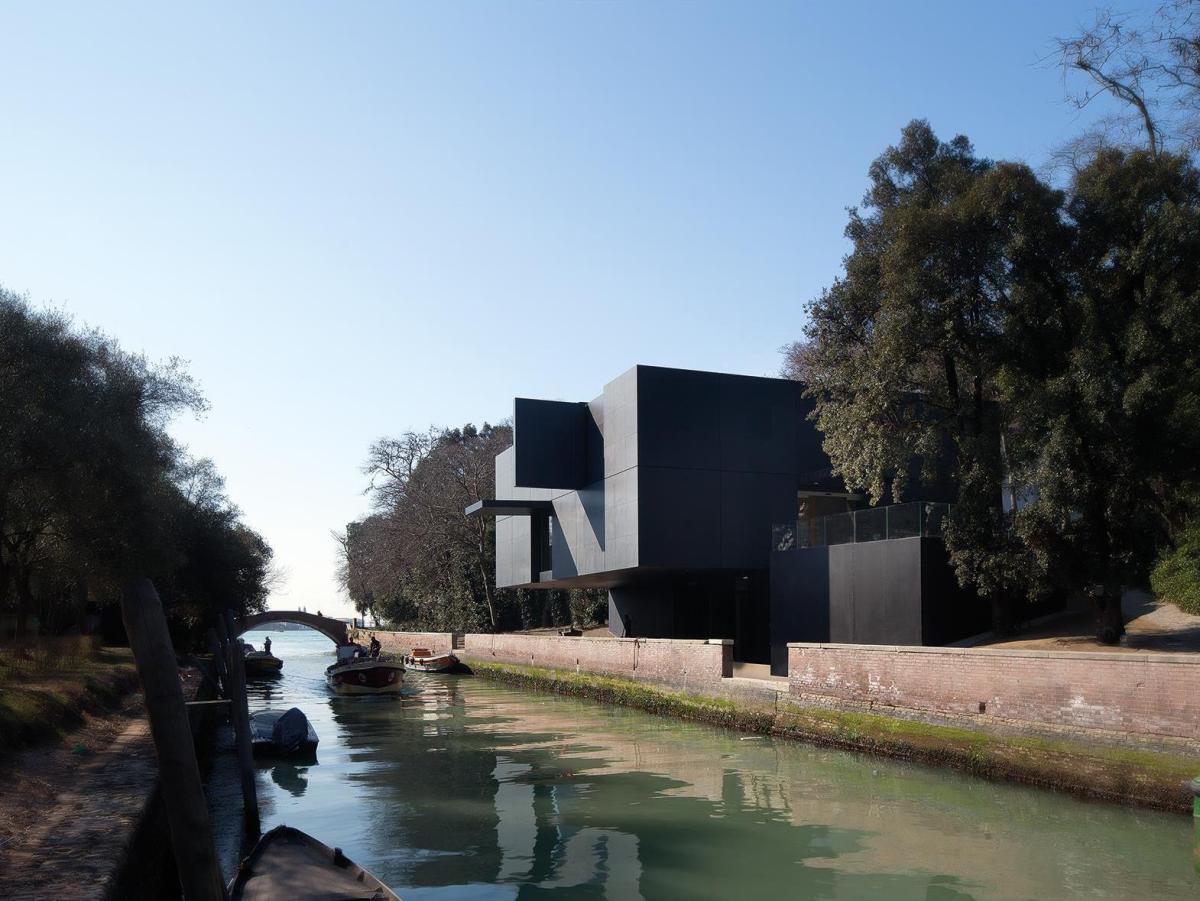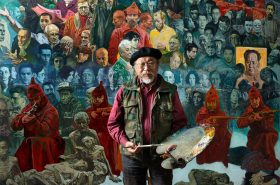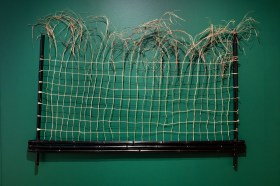The Australian Pavilion at Venice Biennale; Photo John Gillings, supplied
It is that time again, when Australia is soon to send off an artist/s to the Venice Biennale. This year that artist will be Tracey Moffatt.
The first Indigenous female to have solo representation at Venice, Moffat will present MY HORIZON, an installation of large-scale photography and film exploring personal relationships, childhood memories and popular culture.
But there is another aspect of that decision-making process that has caught our interest at ArtsHub. It is not one of culture, race or gender, but rather “muscle”.
To quote the Australia Council: ‘Venice offers unrivaled opportunities for artists. More than 30,000 of the world’s most influential directors, curators, artists, critics, arts writers and arts professionals attend the three-day Vernissage period in this international taste-making, career-defining event.’
ArtsHub has taken a look at the power galleries wield behind those selections. The results beg the question of how representative Australia’s selections really are. Being chosen for Venice is not only a career catalyst for an artist but also an economic benefit, enjoyed also by the gallery’s coffers.
The echelons of power
ArtsHub has crunched the numbers and can report that 15 out of the 32 artists / artist collaboratives selected for the Venice Biennale since 1978 were represented by either the Roslyn Oxley9 Gallery in Sydney or the Anna Schwartz Gallery in Melbourne, at the time of presentation. Two artists (Callum Morton and Jenny Watson) were shared by both. And in the occasion of Patricia Piccinini’s representation that was shared by Roslyn Oxley9 and the Melbourne Tolarno Galleries.
Oxley, who presented 10 artists, had the lion’s share and has had an almost constant run, presenting artists for six of the past seven editions of the Venice Biennale, stretching back to 2003. That consecutive list encompasses Tracey Moffatt, Fiona Hall, Hany Armanious, Claire Healy & Sean Corderio, Callum Morton and Patricia Piccinini; and earlier editions presented Bill Henson, Jenny Watson, Imants Tillers and Rosalie Gascoigne.
2013 was the only year in that 14-year run (2003-2017) when an artist had not come from the Oxley stable – that being Simryn Gill, who is now represented by Utopia Art.
Two New Zealand artists from the Oxley stable have also represented their country at Venice: Bill Culbert (2013) and Michael Parekowhai (2011).
And, Roslyn Oxley9 Gallery artists Fiona Hall (2012), Destiny Deacon (2002), Tony Clark (1992) and Imants Tillers (1982) were selected for the equally iconic dOCUMENTA, held in Kassel Germany every five years; and Dale Frank was selected for the Venice Biennale Aperto in 1986.
ArtsHub approached the gallery, which is currently showing at Art Basel Hong Kong, for a comment. Roslyn Oxley responded by saying: ‘We are delighted, completely thrilled and very proud of Tracey. We have been representing Tracey Moffatt since 1997 and her selection to represent Australia is well deserved.’
Logic behind the numbers
Of course to be Australia’s representative at the Venice Biennale requires a certain career accomplishment and international profile, and there is a logic that those artists would gravitate to – or be picked up by – the top tier galleries in our major art hubs in Australia.
Roslyn Oxley9 Gallery opened in 1982 and Anna Schwartz started dealing a few years earlier in 1980. Both are substantially financed to allow them to attract not only the cream of the Australian art world, but international artists.
Furthermore, Roslyn Oxley9 Gallery has been exhibiting at international art fairs for more than 25 years – arguably ahead of its time in recognising the kind of “entry card” that these events offer artists on a global stage.
So while the numbers are skewed, there is a logic behind that bias. However, the Australian art world is a very different one today than it was in 1978. And the level of international engagement and professionalism across our Australian galleries is a lot more competitive. With the rise of art fairs, the number of biennales globally and cheaper air fairs over the past two decades, one would expect that two-dealer monopoly of representation to have dissipated. Rather, we are witness to an increased monopoly in the past decade.
For that very reason, it is important to acknowledged the other dealers in this Venice charter, most one-off appearance scattered over the 19 editions surveyed, with the exception of Tolarno Galleries (Melbourne) and Utopia Art (Sydney) which have been in two representations each. The others are: Milani Gallery (Brisbane), Dianne Tanzer Gallery (Melbourne), Darren Knight Gallery (Sydney), Australian Galleries, and Arc One (Melbourne).
Precedence and purse-strings
While Australia’s history with Venice dates back to 1954, there was a 20-year hiatus in representation, only resuming activity again in 1978 following the establishment of the Australia Council for the Arts.
With it, Australia presented a new vision of itself to the world, and the Biennale was seen as an important part of that mix.
Since then, the Australia Council has provided a base budget towards each Venice Biennale, which today sits around $1million, which is raised from sponsors, philanthropic foundations and private individuals.
As Commissioner this year, Naomi Milgrom confirmed support from The Balnaves Foundation as the Major Partner, and The University of Melbourne and White Rabbit Gallery as Supporting Partners.
She said: ‘The Venice Biennale is Australia’s key private-public arts partnership and through our collaborative efforts we are able to maximise international profile and opportunities for Tracey Moffatt and the broader Australian contemporary visual arts sector.’
International biennales are big business and there is considerable investment in getting an artist and their work to Venice. Although biennales focus on exhibitions, they were arguably the precursors to art fairs and increasingly exist within the context of the art market.
To pre-sell work heading off to one of these major exhibitions would seem too good an opportunity for a gallery to give up, to further build relationships with top-drawer collectors and museums.
But curator of this year’s selection Natalie King told ArtsHub she was not aware of pre-sales on Moffatt’s work, and that keeping the work stridently “under wraps” until its unveiling in May was part of Venice representation.
This week’s media “preview” was sold on one image alone and rolled out while most high-end curators and collectors, including Oxley, were occupied at the Hong Kong art fairs.
One can be assured, however, that Venice was the hot topic in Hong Kong. Was a wait list started? The average punter will never know.
How does the selection process work?
While the numbers are undeniably skewed in terms of gallery representation, it needs to be said that the selection process is transparent, with a call out that is widely circulated by the Australia Council.
Proposals are invited, and are usually generated by a curator, but can also be submitted by individual artists or artist groups. It seems the only validating criteria (apart from being a national or permanent resident) is that the artist to represent Australia must hold a significant exhibition history both nationally and internationally.
The Council’s website reads: ‘The artist/s will be selected on the basis of the excellence and relevance of their work in the international context of the Venice Biennale. Proposals are sought for the national Pavilion in the Giardini, as well as for alternative spaces in Venice. These will provide opportunities for additional Australian artists to be showcased at the prestigious, high-profile event.’
The proposals are then presented to a panel of peer and industry experts. Moffatt was selected by a five-member panel comprising of Naomi Milgrom AO, Australian Commissioner for the Venice Biennale 2017, Chair of the Selection Advisory Panel; Nicholas Baume, Director and Chief Curator, Public Art Fund, New York; Rebecca Coates, Acting Director, Shepparton Art Museum and independent curator; Lisa Havilah, Director, Carriageworks; and Chris Saines, Director, Queensland Art Gallery I Gallery of Modern Art.
Interestingly, across the same 19 editions of the Venice Biennale surveyed from 1978 – 2017, Linda Michael is the only curator to be chosen twice (Fiona Hall and Patricia Piccinini). It is refreshingly balanced, with each edition presenting a new name and a new curatorial vision.
Further to this economic backstory to the Venice Biennale, is the kind of career ricochet that it offers well beyond the official represented artist.
In more recent years, the Australia Council has widened the junket traveling to Venice from the artist represented, the curator and commissioner of that year’s pavilion (plus a dose of mandatory bureaucrats), to emerging curators, arts writers and arts professionals, aimed at developing their skills and deepen their arts knowledge and to provide networking opportunities with overseas peers and artists.
In many ways this is where the real business of Venice happens.
Chief Executive Officer Tony Grybowski said of the Australia Council’s Professional Development Program: ‘Over the past 20 years, the Australia Council has supported more than 180 art workers involved in this program.’
In a first this year, the Venice Biennale First Nations Program will send a delegation of First Nations Curators to Venice to participate in elements of the Council-led Champions program, providing an important perspective through leading tours of the exhibitions.
Addition to that are Exhibition Team Leaders and Volunteer Exhibition Attendants, again democratically applied for.
So while the numbers may indicate a dealer advantage in the Venice story, the bigger picture says that is it not only Tracey Moffatt heading to Italy, but a flourishing Australian art world that is textured, intelligent and, arguably, inclusive.
Tracey Moffatt: MY HORIZON will be presented within the Australian Pavilion at the 57th Venice Biennale from 13 May – 26 November 2017.





